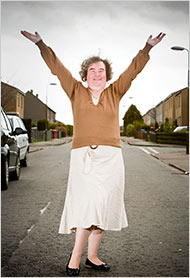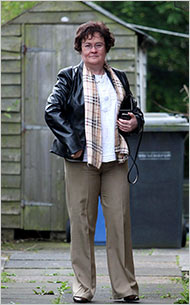|
Yes, Looks Do Matter
By Pam Belluck, The New York Times
April
24, 2009

Andy Barr/News International/ZUMA Press
What you see in the case of Susan Boyle, isn’t what “Britain’s Got Talent” (or the world) expected.
Before she sang, Ms. Boyle seemed to be merely a frumpy 47-year-old unemployed church volunteer who lived alone with her cat, Pebbles, and had, she said, “never been kissed” (a claim that she later took back).
Now, after the video of her performance went viral, a flurry of commentary has focused on how we stereotype people into categories, how we fall victim to the prejudices of ageism or look-ism, and how we should learn, once and for all, not to judge books by their covers.
But many social scientists and others who study the science of stereotyping say there are reasons we quickly size people up based on how they look. Snap judgments about people are crucial to the way we function, they say — even when those judgments are very wrong.
They would even agree with Ms. Boyle herself, who said after her performance that while society is too quick to judge people by appearance, “There is not much you can do about it; it is the way they think; it is the way they are.”
On a very basic level, judging people by appearance means putting them quickly into impersonal categories, much like deciding whether an animal is a dog or a cat. “Stereotypes are seen as a necessary mechanism for making sense of information,” said David Amodio, an assistant professor of psychology at New York University. “If we look at a chair, we can categorize it quickly even though there are many different kinds of chairs out there.”
Eons ago, this capability was of life-and-death importance, and humans developed the ability to gauge other people within seconds.
Susan Fiske, a professor of psychology and neuroscience at Princeton, said that traditionally, most stereotypes break down into two broad dimensions: whether a person appears to have malignant or benign intent and whether a person appears dangerous. “In ancestral times, it was important to stay away from people who looked angry and dominant,” she said.
Women are also subdivided into “traditionally attractive” women, who “don’t look dominant, have baby-faced features,” Professor Fiske said. “They’re not threatening.”
Indeed, attractiveness is one thing that can make stereotypes self-fulfilling and reinforcing. Attractive people are “credited with being socially skilled,” Professor Fiske said, and maybe they are, because “if you’re beautiful or handsome, people laugh at your jokes and interact with you in such a way that it’s easy to be socially skilled.”
“If you’re unattractive, it’s harder to get all that stuff because people don’t seek you out,” she said.
AGE plays a role in forging stereotypes, too, with older people traditionally seen as “harmless and useless,” Professor Fiske said. In fact, she said, research has shown that racial and ethnic stereotypes are easier to change over time than gender and age stereotypes, which are “particularly sticky.”
One reason our brains persist in using stereotypes, experts say, is that often they give us broadly accurate information, even if all the details don’t line up. Ms. Boyle’s looks, for example, accurately telegraphed much about her biography, including her socioeconomic level and lack of worldly experience.
Her behavior on stage reinforced an outsider image. David Berreby, author of “Us and Them,” about why people categorize one another, said the TV audience may have also judged her harshly because, in banter with the judges before singing, she appeared to be trying, awkwardly, to fit in.
“She tried to be chipper, and when they asked her age, she did this little shimmy,” as though she assumed that on such programs “you’re supposed to be kind of sexy and personable, and she got it wrong,” Mr. Berreby said. “Nothing sort of triggers our contempt more than something trying to be acceptable and then failing.”
When people don’t fit our preconceived notions, we tend to ignore the contradictions, until they are too dramatic to overlook. In those cases, said John F. Dovidio, a psychology professor at Yale, we focus on the contradiction — Ms. Boyle’s voice, for example. While that makes us see her as more of an individual, we also “find a way to make the world make sense again, even if the way we do it is to say, ‘This is an exceptional situation.’ It’s easier for me to keep the same categories in my mind and come up with an explanation for the things that are discrepant.”
Even when presented with multiple exceptions to the stereotype, we often keep the broad category and simply create a subtype, Professor Dovidio said.
For example, President Obama challenged negative stereotypes about blacks, but some people may have come up with a subtype of blacks — black professionals — rather than challenge the overall stereotype, Professor Dovidio said. “That does it in the simplest and most cognitively energy-saving way.”

Andrew Milligan/Associated Press
Who’s that girl! Fame has changed Susan Boyle (her look, anyway).
Scientists are finding that stereotypes are not simply stored and retrieved by the brain, but “are associated with general regions in the brain involved in memory and goal-planning,” Professor Amodio said, suggesting that “people recruit stereotypes to kind of help them plan a world that’s consistent with the goal they might have.”
Professor Fiske’s research suggests that those in low status register differently in the brain. “The part of the brain that normally activates when you are thinking about people is surprisingly silent when you’re looking at homeless people,” she said. “It’s kind of a neural dehumanization. Maybe we can’t bear the horrible situation they are in, or we don’t want to get involved, or we’re afraid we might get contaminated.”
But, she said, the neural response is restored when people are asked to focus on what soup the homeless person might like to eat, something that makes one think about the person as someone with wants or goals.
The fact that we can switch our reactions to people —Ms. Boyle’s status went instantly from low to high — also has roots in our physiology, scientists say.
Professor Dovidio said that encountering discrepancies to stereotypes probably “creates a sort of autonomic arousal” in our peripheral nervous system, triggering spikes of cortisol and other indicators of stress. “That autonomic arousal is going to motivate us to do something in that situation,” he said, especially if the situation is dangerous.
Helen Fisher, an anthropology professor at Rutgers, theorizes that in Ms. Boyle’s case, the audience also experienced a “rush of dopamine” from the surprise pleasure of hearing her voice. “Novelty drives up dopamine in the brain and you feel good,” she said.
That may help explain why so many people are drawn to the Susan Boyle story. But their embrace of her and other underestimated underdogs is unlikely to upend our penchant to stereotype.
MODERN society, with its awareness of the prejudices of history and its unprecedented ability to introduce so many different types of people to one another, may dilute or even neutralize some preconceived notions. But others will persist and new ones will form, experts say.
Which may be why, even as she expressed the hope that “maybe this could teach them a lesson, or set an example,” Ms. Boyle has begun to change her appearance in recent days, wearing makeup, dying her frizzy gray hair, and appearing in more stylish clothing.
“The raw material of saying you’re with me and she’s not is always present,” Mr. Berreby said. “It’s not something we came up with because of TV or the car. It’s not connected to modern life at all. It is inherent in the mind.”
More Information on US Elder Rights Issues
Copyright © Global Action on Aging
Terms of Use |
Privacy Policy | Contact
Us
|



